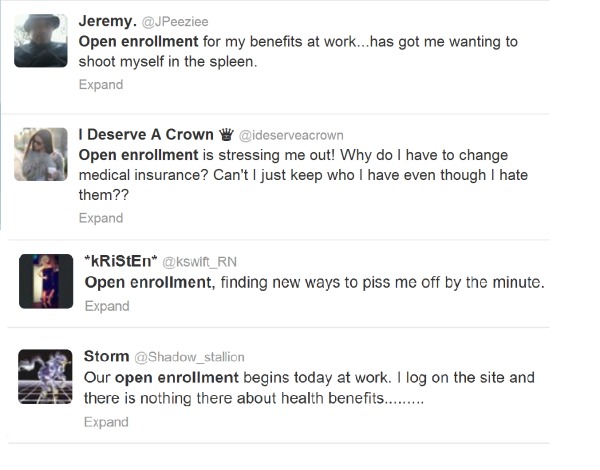ANDREA TARRELL
HNI Marketing Director
In most companies, open enrollment is the time of the year when any and all communication about benefits and wellness gets dropped on employees like a bomb. It’s not the time of the year that most look forward to.
In a 2011 survey, Aflac reported that three-quarters of us admit to making mistakes during open enrollment, and that only 40% say that they feel well informed about the benefits that are offered at their company. [YIKES!] Unfortunately, mistakes from misunderstanding can be costly to employees and cause them to resent HR or their employer — or at the very least not fully appreciate the value of the benefits the company is offering to them.
How Employees Really Feel About Open Enrollment
Wondering how employees REALLY feel about the process of electing benefits for the coming year? Here are some candid reactions from Twitter as to how some employees perceive the process:

But let’s face it: employees aren’t the only ones open enrollment is a headache for. HR folks aren’t always super enthusiastic about it either, as “Elaine” reports in her tweet:

What Are Your People Saying About Open Enrollment?
What are your people saying about open enrollment? Is it better or worse than what’s out there in the Twitterverse? (And do you even want to know?)
Benefits are intended to be beneficial — hence the name. If the only emotion people feel in relations to benefits is the frustration and confusion at open enrollment, your company is falling short of the goal, no matter how robust the benefits you offer.
Clear, concise, and engaging benefits communication is the key to improving employee’s opinion toward benefits and open enrollment. It certainly takes energy and resources to design effective communications, but the added time and dollars spent are likely a fraction of what you’re spending on your benefits as a whole!
Related Posts:
Get More Bang for Your Buck with Innovative Benefits Offerings
3 Benefits of Onsite Care Clinics
5 Tips to Keep Benefits Communication Flowing Year Round
Communicating Employee Benefits Can’t Just Happen at Enrollment
.png?width=69&height=53&name=Acrisure%20Logo%20(White%20Horizontal).png)


